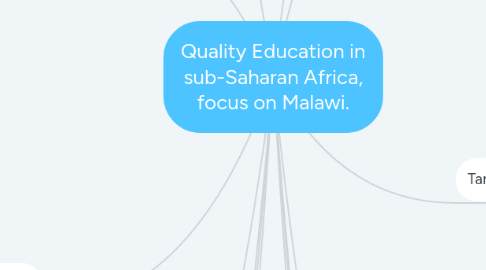
1. Vocational and tertiary education, including university
1.1. Co op by teachers for teachers.
1.2. Many of the quality issues faced in Malawian schools are due to a lack of motivation by the teachers. They face poor working conditions, weak social amenities and lack health coverage.
2. Increase the number of youth and adults who have relevant skills, including technical and vocational skills, for employment, decent jobs and entrepreneurship.
2.1. Improve motivation for teachers. Find a way to improve working conditions, social amenities and health coverage.
2.2. Small and medium enterprises make up about 1.7 million people, equivalent to 38% of Malawi’s total working age population. Women make up 46% of these employment figures.
2.2.1. Provide network database for Small and Medium enterprises
2.2.2. Ensure better functioning of value chains
2.2.2.1. Foster business-to-business linkages
2.2.2.2. PSDP identified pigeon peas a key export crop. It is estimated this market could grow to over $100 million over five years, and would benefit small farmers in the value chain.
2.2.3. Improve information, skills, and standards
2.2.4. Increase access to finance.
2.2.5. Teach business skills.
2.3. Soya, the second highest agricultural import in the country. Over 400,000 households produce it as a cash crop, but at very low yield because of poor seed and farming practices.
2.3.1. Education on farming practices.
2.3.2. Provides resources for farms.
2.3.3. Teach farmers how to sell their crops.
2.3.4. Information technologies
2.4. Increasing access to alternative pathways of learning for out of school adolescents,
3. Equal Opportunity for Education
3.1. Eliminate gender disparities in education
3.2. Ensure equal access to all levels of education and vocational training for the vulnerable, including persons with disabilities, indigenous peoples and children in vulnerable situations
3.2.1. NZ teachers to help with students of vulnerable situations (online).
3.2.2. Provide education for teachers to help with vulnerable students.
3.3. in Malawi, 52 percent of girls are not learning basic competencies at the end of primary school compared to 44 percent of boys.
3.3.1. Platform for basic competencies
3.3.2. Create interactive learning experiences
3.3.3. Education resources
3.3.4. Up skilling at a low cost (teachers)
3.4. Form management committees which are responsible for school operations and for reinforcing effective learning.
4. Education and Employment
4.1. Have a business where women are able to make a fair wage (making t-shirts etc). Money goes towards Education.
4.2. Teachers: - The Government has made provisions that for every 60 children there is a teacher allocated but in most cases the teacher pupil ratio is higher.
4.2.1. Teaching training provided on the Job - Taught by qualified teacher.
4.2.2. Teacher training
4.2.3. Aim to improve benefits of being a teacher. Teach career development.
4.3. Teaching model that helps children to understand numeracy and english in a way that is both fun and interactive.
4.4. Help people from ethnic minorities to become teachers in order to work in their own communities. Ensures that children are taught by teachers familiar with their culture and language.
4.5. Teaching training provided on the Job - Taught by qualified teacher.
5. Numeracy and Literacy
5.1. Provide low cost educational resources to improve Numeracy and Literacy.
5.2. Provide an I-pad or computer to schools equipped with learning platforms, books, educational resources, as well as soft skills.
5.3. PEER Leadership Program to equip primary school teachers with specialist subject knowledge and teaching methods to enhance children's literacy and their access to the syllabus in all subjects.
5.3.1. Literacy Leaders are supported to develop mentoring skills in order to assist their teaching colleagues and spread the benefits.
6. Educational partnerships between New Zealand and Malawi to develop global citizenship for children in both countries.
7. Children's clubs
7.1. Provide activities for children aged 5 to 16. Take part in a range of activities including advice on practical living, understanding the Bible, sports and art.
7.2. Student's trained as teachers to help younger kids.
8. 617 million youth worldwide lack basic mathematics and literacy skills. Address this.
8.1. All youth and a substantial proportion of adults, both men and women, achieve literacy and numeracy
9. Early childhood development
9.1. Community-based care centres
9.2. Globally over 200 million children do not reach their developmental potential in the first 5 years of life because they live in poverty, and have poor health services, nutrition and psycho¬social care
9.2.1. Health Care Sector has the opportunity to help strengthen families’ efforts to promote children’s early development.
9.2.2. Provide info and recommendations for cognitive stimulation and social support to young children.
9.3. Play and communication activities for families to stimulate the learning of their children.
9.4. Provide health, nursery education and safeguarding services.
9.5. Preschools are run on a voluntary basis and remain unregistered.
9.6. Play centre community cooperative model
10. Target Markets
10.1. Teachers
10.2. Youth
10.3. Men & Women
10.4. Young adults
10.5. Children
10.5.1. Teens
10.5.2. Infants
10.5.3. Toddlers
10.6. Government
10.7. Farmers
10.8. Workers
10.9. Volunteers
10.10. Stakeholders
10.11. Families
11. Improvement of teaching materials, equipment, and furniture and the building of educational institutions, their renovation and maintenance.
11.1. Hygiene: - Children have to live in an environment that has very poor sanitation, without proper toilets and clean water sources.
11.2. Provide low cost materials & instructions in order to build schools.
11.3. Can use recycled plastic bottles to make a 'cooling system' to go into the windows at Schools.
11.4. A national shortage of classrooms, qualified teachers and basic teaching materials such as textbooks.
11.5. Collect plastic bottles, refine them and be able to turn them into concrete. Provide concrete as resource to build schools.
11.5.1. Potentially give equipment for citizens to do it themselves.
11.5.2. Training
11.5.3. Selling concrete opportunity for Citizens.
11.5.4. Reduces plastic
11.5.5. Reuse traffic cones (flatten during project)
